Novel Collection Equipment Loaded with Superhydrophobic Sponge for Continuous Oil/Water Separation from Offshore Environments
Abstract
1. Introduction
2. Materials and Methods
2.1. Materials
2.2. Fabrication of Superhydrophobic Sponge
2.3. Characterization
2.4. Collection Equipment
2.5. Adsorption Performance
2.6. Continuous Oil/Water Separation Performance
3. Results
3.1. Characterization
3.2. Adsorption Performance
3.3. Continuous Oil/Water Separation Performance
4. Conclusions
Author Contributions
Funding
Institutional Review Board Statement
Informed Consent Statement
Data Availability Statement
Conflicts of Interest
References
- Li, Y.; Ping, H.; Ma, Z.-H.; Pan, L.-G. Statistical analysis of sudden chemical leakage accidents reported in China between 2006 and 2011. Environ. Sci. Pollut. Res. Int. 2014, 21, 5547–5553. [Google Scholar] [CrossRef]
- Hou, J.; Gai, W.-M.; Cheng, W.-Y.; Deng, Y.-F. Hazardous chemical leakage accidents and emergency evacuation response from 2009 to 2018 in China: A review. Saf. Sci. 2021, 135, 105101. [Google Scholar] [CrossRef]
- Hassler, B. Accidental Versus Operational Oil Spills from Shipping in the Baltic Sea: Risk Governance and Management Strategies. Ambio 2011, 40, 170–178. [Google Scholar] [CrossRef] [PubMed]
- McNutt, M.K.; Camilli, R.; Crone, T.J.; Guthrie, G.D.; Hsieh, P.A.; Ryerson, T.B.; Savas, O.; Shaffer, F. Review of flow rate estimates of the Deepwater Horizon oil spill. Proc. Natl. Acad. Sci. USA 2012, 109, 20260–20267. [Google Scholar] [CrossRef]
- Lan, R.; Qiao, B. Construction of Loss Assessment Method of Eco-service Value in Sea Area Polluted by Chemical Leakage Accidents Based on Ecological Impact Prediction Model. IOP Conf. Ser. Earth Environ. Sci. 2019, 310, 052065. [Google Scholar] [CrossRef]
- By, A.; Ysl, B. Designing an effective mitigation system based on the physical barrier for hazardous chemical leakage accidents. J. Ind. Eng. Chem. 2019, 80, 370–375. [Google Scholar]
- Dou, Z.; Mebarki, A.; Cheng, Y.; Zheng, X.; Jiang, J.; Wang, Y.; Li, Y.; Li, J. Review on the emergency evacuation in chemicals-concentrated areas. J. Loss Prev. Process. Ind. 2019, 60, 35–45. [Google Scholar] [CrossRef]
- Radovic, J.; Rial, D.; Lyons, B.; Harman, C.; Viñas, L.; Beiras, R.; Readman, J.W.; Thomas, K.V.; Bayona, J.M. Post-incident monitoring to evaluate environmental damage from shipping incidents: Chemical and biological assessments. J. Environ. Manag. 2012, 109, 136–153. [Google Scholar] [CrossRef] [PubMed]
- Zhang, H.D.; Zheng, X.P. Characteristics of hazardous chemical accidents in China: A statistical investigation. J. Loss Prevent. Proc. 2012, 25, 686–693. [Google Scholar] [CrossRef]
- Visco, A.; Quattrocchi, A.; Nocita, D.; Montanini, R.; Pistone, A. Polyurethane Foams Loaded with Carbon Nanofibers for Oil Spill Recovery: Mechanical Properties under Fatigue Conditions and Selective Absorption in Oil/Water Mixtures. Nanomaterials 2021, 11, 735. [Google Scholar] [CrossRef]
- Osipov, K.; Mokochunina, T.V.; Panyukova, D.I.; Trukhina, M.V.; Maryutina, T.A. A comparison of standard test methods for determining the laboratory effectiveness of oil spill dispersants: Their benefits and drawbacks. Ind. Lab. Diagn. Mater. 2021, 87, 23–29. [Google Scholar] [CrossRef]
- Yu, P.; Bao, R.-Y.; Shi, X.-J.; Yang, W.; Yang, M.-B. Self-assembled high-strength hydroxyapatite/graphene oxide/chitosan composite hydrogel for bone tissue engineering. Carbohydr. Polym. 2017, 155, 507–515. [Google Scholar] [CrossRef] [PubMed]
- Mapelli, F.; Scoma, A.; Michoud, G.; Aulenta, F.; Boon, N.; Borin, S.; Kalogerakis, N.; Daffonchio, D. Biotechnologies for Marine Oil Spill Cleanup: Indissoluble Ties with Microorganisms. Trends Biotechnol. 2017, 35, 860–870. [Google Scholar] [CrossRef]
- Mahandari, C.P.; Yamin, M.; Asandi, D. Tar Balls Collector for Mechanical Recovery in Combating Oil Spill on the Marine Environment. Appl. Mech. Mater. 2015, 776, 331–336. [Google Scholar] [CrossRef]
- Xia, C.; Li, Y.; Fei, T.; Gong, W. Facile one-pot synthesis of superhydrophobic reduced graphene oxide-coated polyurethane sponge at the presence of ethanol for oil-water separation. Chem. Eng. J. 2018, 345, 648–658. [Google Scholar] [CrossRef]
- Xie, A.; Chen, Y.; Cui, J.; Lang, J.; Li, C.; Yan, Y.; Dai, J. Facile and green fabrication of superhydrophobic sponge for continuous oil/water separation from harsh environments. Colloids Surf. A 2019, 563, 120–129. [Google Scholar] [CrossRef]
- Khormali, A.; Koochi, M.R.; Varfolomeev, M.A.; Ahmadi, S. Experimental study of the low salinity water injection process in the presence of scale inhibitor and various nanoparticles. J. Pet. Explor. Prod. Technol. 2022, 13, 903–916. [Google Scholar] [CrossRef]
- Safari, M.; Rahimi, A.; Lah, R.M.; Gholami, R.; Khur, W.S. Sustaining sulfate ions throughout smart water flooding by nanoparticle based scale inhibitors. J. Mol. Liq. 2020, 310, 113250–113259. [Google Scholar] [CrossRef]
- Yan, X.; Liu, F.; Mu, G.; Zhou, Z.; Xie, Y.; Li, L.; Yang, Y.; Wang, X. Adsorption of toluene vapours on micro–meso hierarchical porous carbon. Micro Nano Lett. 2018, 13, 641–645. [Google Scholar] [CrossRef]
- Ongarbayev, Y.; Belgibayeva, A.; Kudaybergenov, K.; Mansurov, Z. Oil Spill Cleanup from Sea Water by Porous Sorbents. Eurasian Chem.-Technol. J. 2015, 17, 41–45. [Google Scholar] [CrossRef]
- Nyankson, E.; Rodene, D.; Gupta, R.B. Advancements in Crude Oil Spill Remediation Research after the Deepwater Horizon Oil Spill. Water Air Soil Pollut. 2015, 227, 29–51. [Google Scholar] [CrossRef]
- Li, H.; Wu, W.; Bubakir, M.M.; Chen, H.; Zhong, X.; Liu, Z.; Ding, Y.; Yang, W. Polypropylene fibers fabricated via a needleless melt-electrospinning device for marine oil-spill cleanup. J. Appl. Polym. Sci. 2014, 131, 40080–40089. [Google Scholar] [CrossRef]
- Broje, V.; Keller, A.A. Improved Mechanical Oil Spill Recovery Using an Optimized Geometry for the Skimmer Surface. Environ. Sci. Technol. 2006, 40, 7914–7918. [Google Scholar] [CrossRef] [PubMed]
- Zhang, X.; Shi, F.; Niu, J.; Jiang, Y.; Wang, Z. Superhydrophobic surfaces: From structural control to functional application. J. Mater. Chem. 2008, 18, 621–633. [Google Scholar] [CrossRef]
- Yan, X.; Xie, Y.; Zhao, S.; Sheng, X.; Zhou, Z. Preparation of modified superhydrophobic sponge and its application in xylene leakage recovery. Desalin. Water Treat. 2020, 1, 187–194. [Google Scholar] [CrossRef]
- Abdelhafeez, I.A.; Zhou, X.; Yao, Q.; Yu, Z.; Gong, Y.; Chen, J. Multifunctional Edge-Activated Carbon Nitride Nanosheet-Wrapped Polydimethylsiloxane Sponge Skeleton for Selective Oil Absorption and Photocatalysis. ACS Omega 2020, 5, 4181–4190. [Google Scholar] [CrossRef]
- Feng, Y.; Yao, J. Design of Melamine Sponge-Based Three-Dimensional Porous Materials toward Applications. Ind. Eng. Chem. Res. 2018, 57, 7322–7330. [Google Scholar] [CrossRef]
- Lv, W.Y.; Mei, Q.; Xiao, J.; Du, M.; Zheng, Q. 3D Multiscale Superhydrophilic Sponges with Delicately Designed Pore Size for Ultrafast Oil/Water Separation. Adv. Funct. Mater. 2017, 27, 1704293. [Google Scholar] [CrossRef]
- Lei, Z.; Deng, Y.; Wang, C. Multiphase surface growth of hydrophobic ZIF-8 on melamine sponge for excellent oil/water separation and effective catalysis in a Knoevenagel reaction. J. Mater. Chem. A 2018, 6, 3258–3263. [Google Scholar] [CrossRef]
- Li, L.; Li, B.; Sun, H.; Zhang, J. Compressible and conductive carbon aerogels from waste paper with exceptional performance for oil/water separation. J. Mater. Chem. A 2017, 5, 14858–14864. [Google Scholar] [CrossRef]
- Zhai, Z.; Zheng, Y.; Du, T.; Tian, Z.; Liu, Z. Green and sustainable carbon aerogels from starch for supercapacitors and oil-water separation. Ceram Int. 2021, 47, 22080–22087. [Google Scholar] [CrossRef]
- Cao, J.; Wang, D.; An, P.; Zhang, J.; Feng, S. Highly compression-tolerant and durably hydrophobic macroporous silicone sponges synthesized by a one-pot click reaction for rapid oil/water separation. J. Mater. Chem. A 2018, 6, 18025–18030. [Google Scholar] [CrossRef]
- Shin, J.H.; Heo, J.-H.; Jeon, S.; Park, J.H.; Kim, S.; Kang, H.-W. Bio-inspired hollow PDMS sponge for enhanced oil–water separation. J. Hazard. Mater. 2019, 365, 494–501. [Google Scholar] [CrossRef] [PubMed]
- Xu, J.; Cao, R.; Li, M.; Chen, G.; Tian, J. Superhydrophobic and superoleophilic cuttlebone with an inherent lamellar structure for continuous and effective oil spill cleanup. Chem. Eng. J. 2021, 420, 127596–127606. [Google Scholar] [CrossRef]
- Ding, Y.; Xu, W.; Yu, Y.; Hou, H.; Zhu, Z. One-Step Preparation of Highly Hydrophobic and Oleophilic Melamine Sponges via Metal-Ion-Induced Wettability Transition. ACS Appl. Mater. Interfaces 2018, 10, 6652–6660. [Google Scholar] [CrossRef] [PubMed]
- Nemanič, V.; Zajec, B.; Žumer, M.; Figar, N.; Kavšek, M.; Mihelič, I. Synthesis and characterization of melamine–formaldehyde rigid foams for vacuum thermal insulation. Appl. Energy 2014, 114, 320–326. [Google Scholar] [CrossRef]
- Oribayo, O.; Feng, X.; Rempel, G.L.; Pan, Q. Modification of formaldehyde-melamine-sodium bisulfite copolymer foam and its application as effective sorbents for clean up of oil spills. Chem. Eng. Sci. 2017, 160, 384–395. [Google Scholar] [CrossRef]
- Stolz, A.; Le Floch, S.; Reinert, L.; Ramos, S.M.; Tuaillon-Combes, J.; Soneda, Y.; Chaudet, P.; Baillis, D.; Blanchard, N.; Duclaux, L.; et al. Melamine-derived carbon sponges for oil-water separation. Carbon 2016, 107, 198–208. [Google Scholar] [CrossRef]
- Li, Y.; Zhang, Z.; Wang, M.; Men, X.; Xue, Q. One-pot fabrication of nanoporous polymer decorated materials: From oil-collecting devices to high-efficiency emulsion separation. J. Mater. Chem. A 2017, 5, 5077–5087. [Google Scholar] [CrossRef]
- Guo, Y.; Wang, Q. Facile approach in fabricating superhydrophobic coatings from silica-based nanocomposite. Appl. Surf. Sci. 2010, 257, 33–36. [Google Scholar] [CrossRef]
- Liu, L.; Chen, C.; Yang, S.; Xie, H.; Gong, M.; Xu, X. Fabrication of superhydrophilic–underwater superoleophobic inorganic anti-corrosive membranes for high-efficiency oil/water separation. Phys. Chem. Chem. Phys. 2015, 18, 1317–1325. [Google Scholar] [CrossRef]
- Ge, J.; Ye, Y.-D.; Yao, H.-B.; Zhu, X.; Wang, X.; Wu, L.; Wang, J.-L.; Ding, H.; Yong, N.; He, L.-H.; et al. Pumping through Porous Hydrophobic/Oleophilic Materials: An Alternative Technology for Oil Spill Remediation. Angew. Chem. Int. Ed. 2014, 53, 3612–3616. [Google Scholar] [CrossRef] [PubMed]
- ASTM F 2709-15; Standard Test Method for Determining a Measured Nameplate Recovery Rate of Stationary Oil Skimmer Systems. American Society for Testing and Materials: Philadelphia, PA, USA,, 2015.
- Wang, H.; Xue, Y.; Ding, J.; Feng, L.; Wang, X.; Lin, T. Durable, Self-healing superhydrophobic and superoleophobic surfaces from fluorinated-decyl polyhedral oligomeric silses quioxane and hydrolyzed fluorinated alkyl silane. Angew. Angew. Chem. Eeit 2011, 50, 11433–11436. [Google Scholar] [CrossRef] [PubMed]
- Zhang, X.; Zhi, D.; Zhu, W.; Sathasivam, S.; Parkin, I.P. Facile fabrication of durable superhydrophobic SiO2/polyurethane composite sponge for continuous separation of oil from water. RSC Adv. 2017, 7, 11362–11366. [Google Scholar] [CrossRef]
- Wang, J.; Kong, Q.G.; Zhang, L.; Qian, H.Y. Preparation and properties of fluorinated low surface energy modified superamphiphobic coatings. Surf. Technol. 2018, 47, 76–82. [Google Scholar]
- Kulkarni, S.A.; Ogale, S.B.; Vijayamohanan, K.P. Tuning the hydrophobic properties of silica particles by surface silanization using mixed self-assembled monolayers. J. Colloid Interface Sci. 2008, 318, 372–379. [Google Scholar] [CrossRef] [PubMed]
- Sam, E.K.; Liu, J.; Lv, X. Surface Engineering Materials of Superhydrophobic Sponges for Oil/Water Separation: A Review. Ind. Eng. Chem. Res. 2021, 60, 2353–2364. [Google Scholar] [CrossRef]
- Zhu, Y.; Xie, W.; Xing, T.; Li, J. pH-Induced non-fouling membrane for effective separation of oil-in-water emulsion. J. Membr. Sci. 2015, 477, 131–138. [Google Scholar] [CrossRef]
- Wei, C.; Lin, L.; Zhao, Y.; Zhang, X.Y.; Huang, X.J. Fabrication of pH-Sensitive Superhydrophilic/Underwater Superoleophobic Poly(vinylidene fluoride)-graft-(SiO2 Nanoparticles and PAMAM Dendrimers) Membranes for Oil-Water Separation. ACS Appl. Mater. Int. 2020, 12, 19130–19139. [Google Scholar] [CrossRef]
- Zhou, S.K.; Liu, Y.J.; Jiang, H.Y.; Deng, W.J.; Zeng, G.M. Adsorption of U(VI) from Aqueous Solution by a Novel Chelating Adsorbent Functionalized with Amine Groups: Equilibrium, Kinetic, and Thermodynamic Studies. Environ. Eng. Sci. 2017, 35, 53–61. [Google Scholar] [CrossRef]
- Abbasizadeh, S.; Keshtkar, A.R.; Mousavian, M.A. Sorption of heavy metal ions from aqueous solution by a novel cast PVA/TiO2 nanohybrid adsorbent functionalized with amine groups. J. Ind. Eng. Chem. 2014, 20, 1656–1664. [Google Scholar] [CrossRef]
- Gui, X.; Li, H.; Wang, K.; Wei, J.; Jia, Y.; Li, Z.; Fan, L.; Cao, A.; Zhu, H.; Wu, D. Recyclable carbon nanotube sponges for oil absorption. Acta Mater. 2011, 59, 4798–4804. [Google Scholar] [CrossRef]
- Peng, M.; Chen, G.; Zeng, G.; Chen, A.; He, K.; Huang, Z.; Hu, L.; Shi, J.; Li, H.; Yuan, L.; et al. Superhydrophobic kaolinite modified graphene oxideemelamine sponge with excellent properties for oilewater separation. Appl. Clay Sci. 2018, 163, 63–71. [Google Scholar] [CrossRef]
- Ke, Q.; Jin, Y.; Jiang, P.; Yu, J. Oil/Water Separation Performances of Superhydrophobic and Superoleophilic Sponges. Langmuir 2014, 30, 13137–13142. [Google Scholar] [CrossRef]
- Cao, N.; Yang, B.; Barras, A.; Szunerits, S.; Boukherroub, R. Polyurethane sponge functionalized with superhydrophobic nanodiamond particles for efficient oil/water separation. Chem. Eng. J. 2017, 307, 319–325. [Google Scholar] [CrossRef]
- Wang, J.; Zheng, Y. Oil/water mixtures and emulsions separation of stearic acid-functionalized sponge fabricated via a facile one-step coating method. Sep. Purif. Technol. 2017, 181, 183–191. [Google Scholar] [CrossRef]
- Khosravi, M.; Azizian, S. Synthesis of a Novel Highly Oleophilic and Highly Hydrophobic Sponge for Rapid Oil Spill Cleanup. ACS Appl. Mater. Interfaces 2015, 7, 25326–25333. [Google Scholar] [CrossRef]
- Choi, S.-J.; Kwon, T.; Im, H.; Moon, D.-I.; Baek, D.J.; Seol, M.-L.; Duarte, J.P.; Choi, Y.-K. A Polydimethylsiloxane (PDMS) Sponge for the Selective Absorption of Oil from Water. ACS Appl. Mater. Interfaces 2011, 3, 4552–4556. [Google Scholar] [CrossRef]
- Zhao, X.; Li, L.; Li, B.; Zhang, J.; Wang, A. Durable superhydrophobic/superoleophilic PDMS sponges and their applications in selective oil absorption and in plugging oil leakages. J. Mater. Chem. A 2014, 2, 18281–18287. [Google Scholar] [CrossRef]
- Washburn, E.W. The dynamics of capillary flow. Phys. Rev. J. Arch. 1921, 17, 273–283. [Google Scholar] [CrossRef]
- Wang, G.; Zeng, Z.; Wu, X.; Ren, T.; Han, J.; Xue, Q. Three-dimensional structured sponge with high oil wettability for the clean-up of oil contaminations and separation of oil–water mixtures. Polym. Chem. 2014, 5, 5942–5948. [Google Scholar] [CrossRef]
- Wu, Z.-Y.; Li, C.; Liang, H.-W.; Zhang, Y.-N.; Wang, X.; Chen, J.-F.; Yu, S.-H. Carbon nanofiber aerogels for emergent cleanup of oil spillage and chemical leakage under harsh conditions. Sci. Rep. 2014, 4, 4079. [Google Scholar] [CrossRef] [PubMed]
- Sutar, R.S.; Kalel, P.J.; Latthe, S.S.; Kumbhar, D.A.; Mahajan, S.S.; Chikode, P.P.; Patil, S.S.; Kadam, S.S.; Gaikwad, V.H.; Xing, R.; et al. Superhydrophobic PVC/SiO2 Coating for Self-Cleaning Application. Macromol. Symp. 2020, 393, 034–040. [Google Scholar]

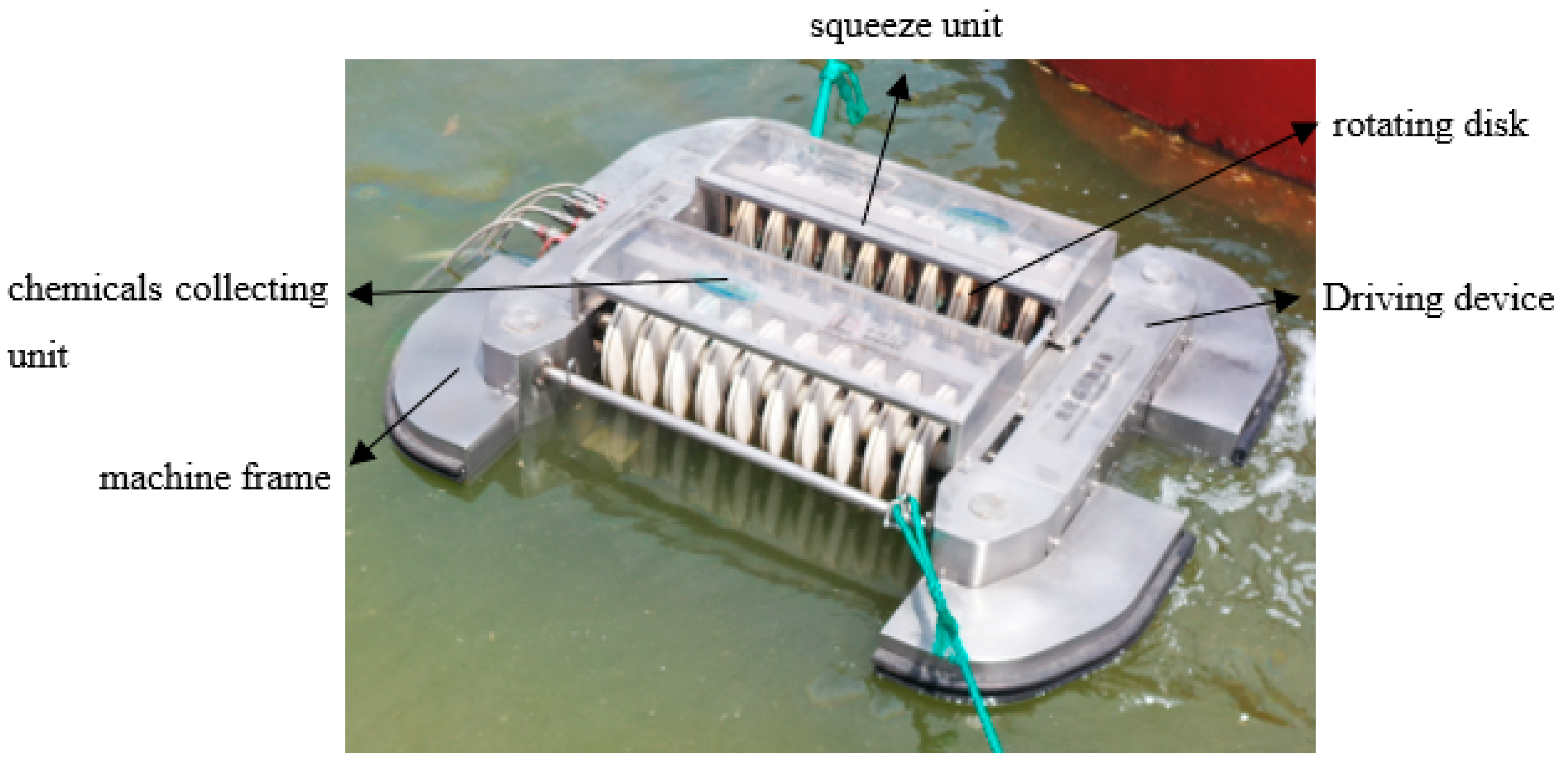


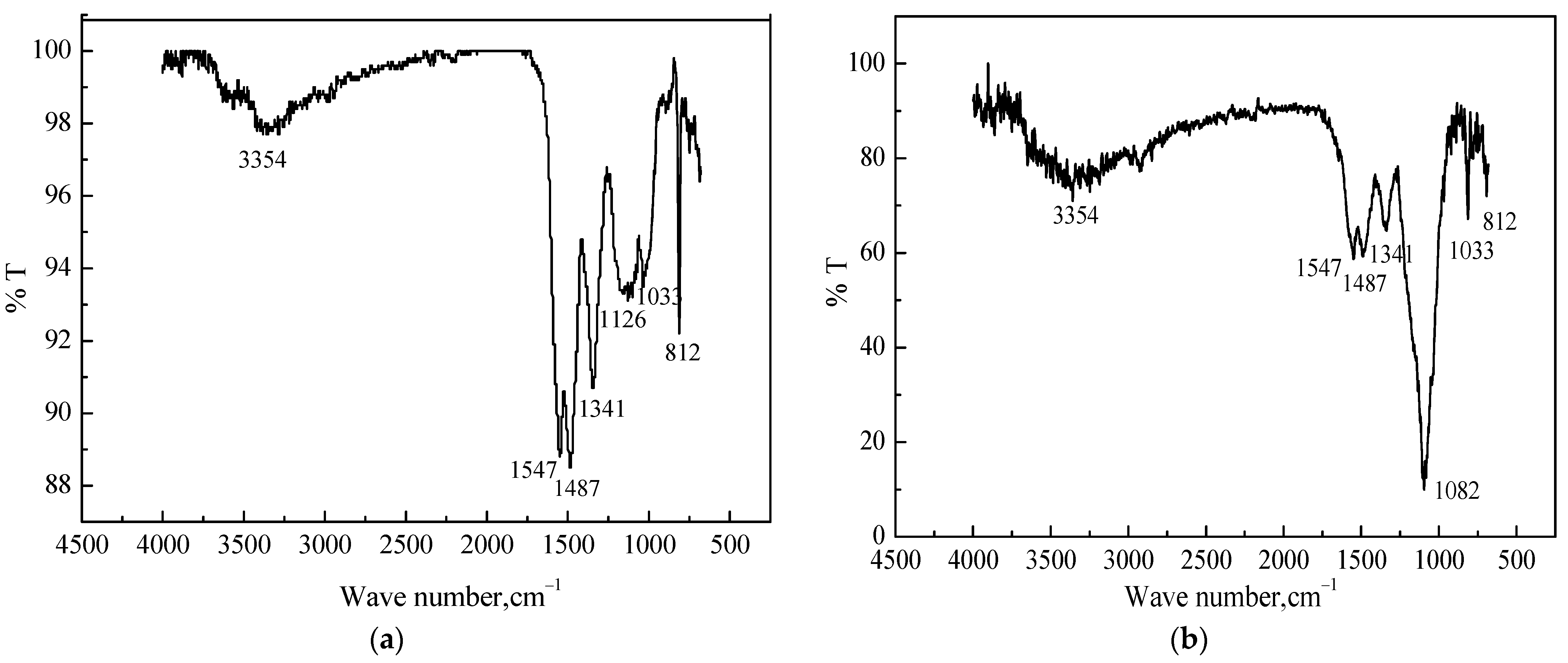
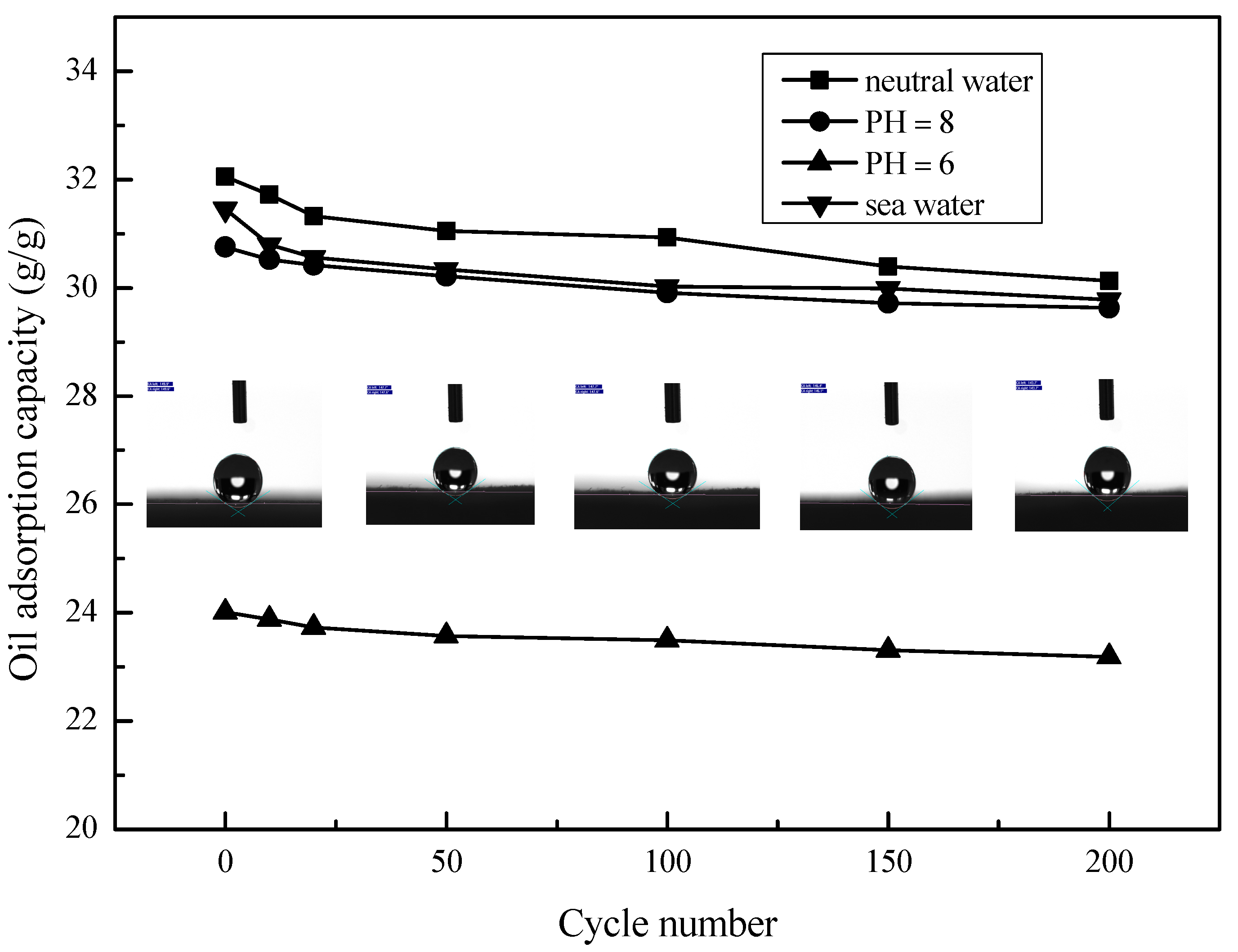
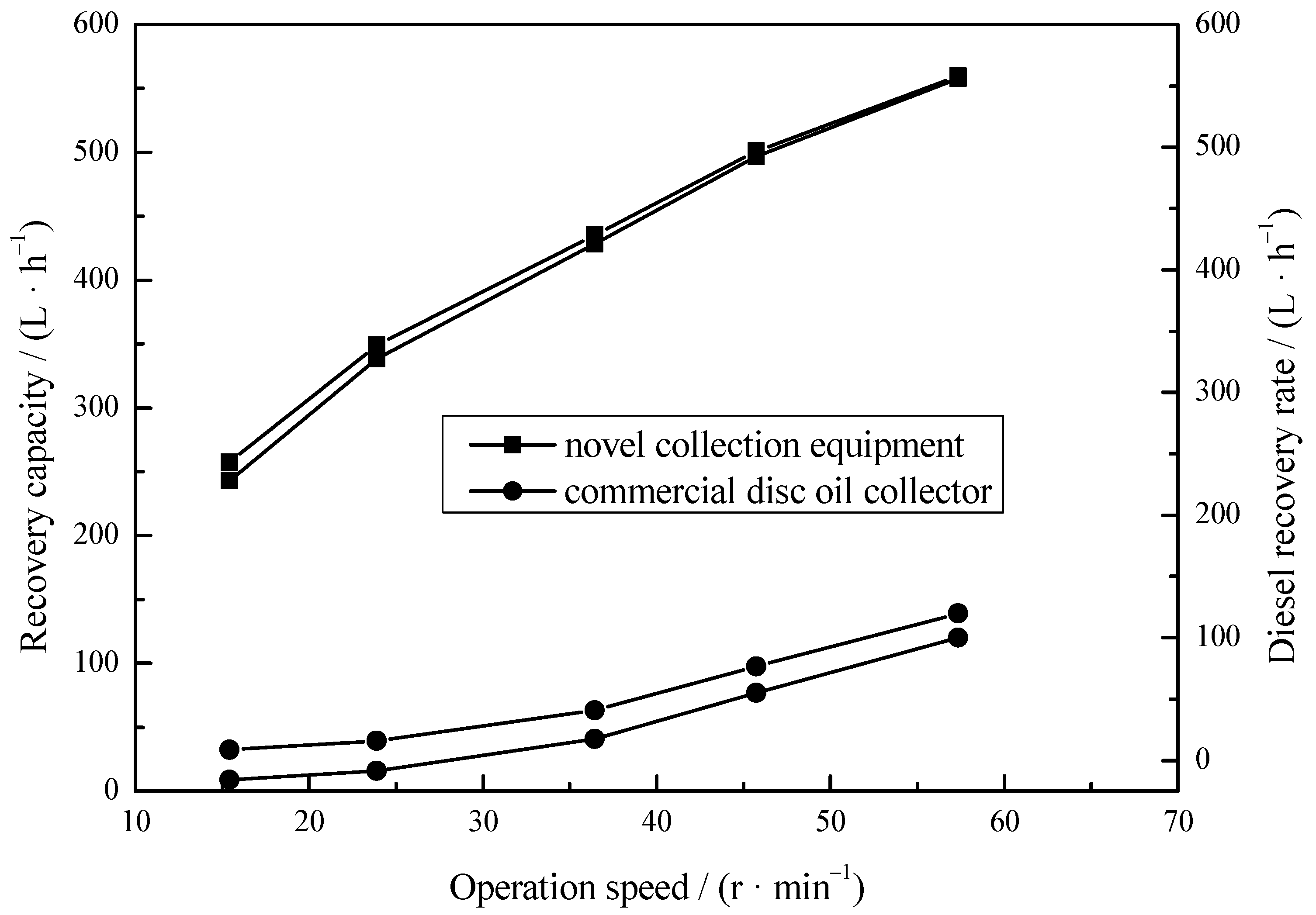
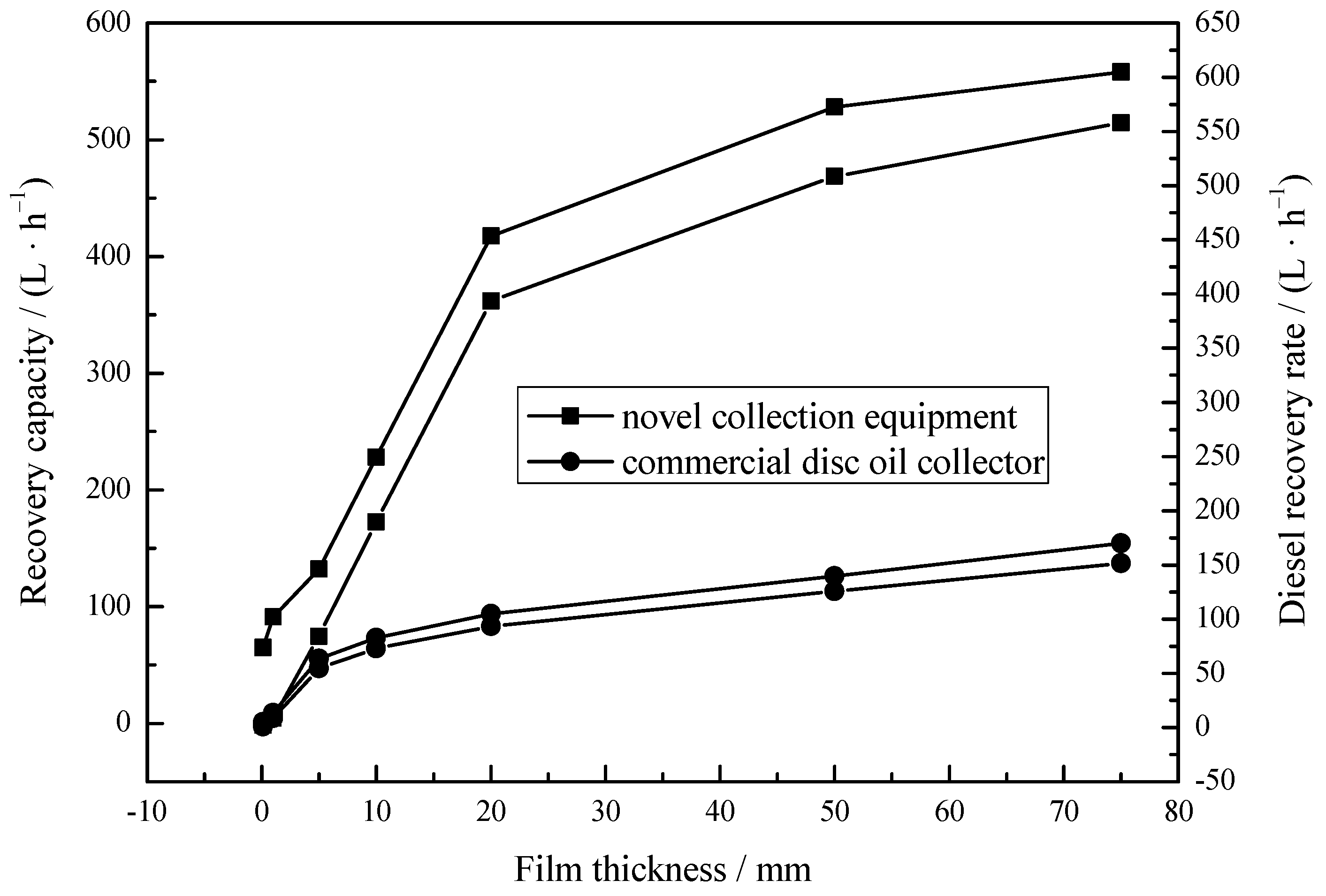
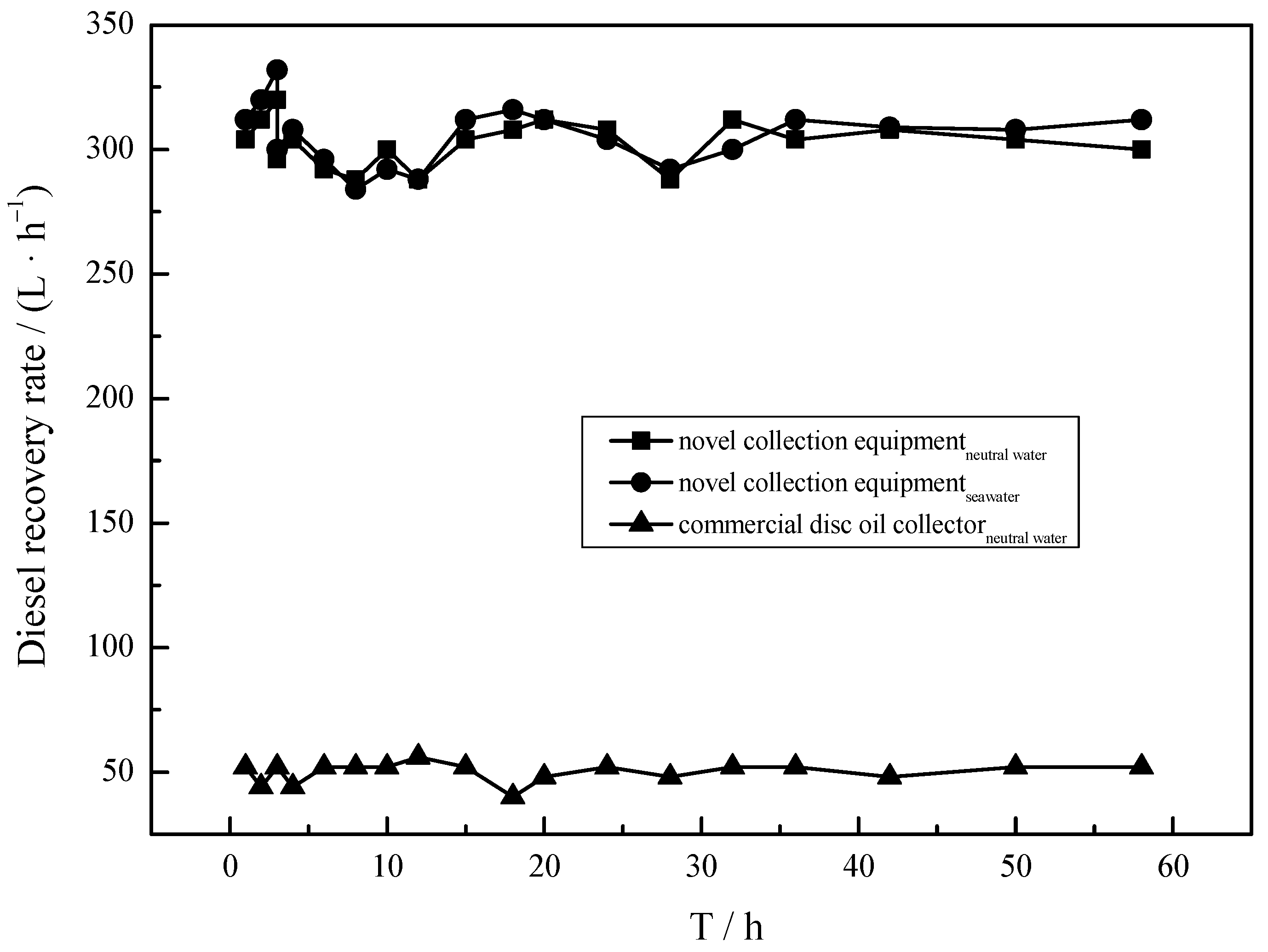
| Samples | Width/mm | Thickness/mm | Maximum Load/N | Pressure/N·mm−2 | Width/mm |
|---|---|---|---|---|---|
| MS | 20.00 | 21.00 | 54.75 | 0.130 | 115.23 |
| MS@PVC@SiO2 | 20.00 | 21.00 | 57.21 | 0.136 | 118.02 |
| Samples | Oil Adsorption Capacity (g/g) | Water Adsorption Capacity (g/g) | Solutions |
|---|---|---|---|
| MS | 2.45 | 56.67 | Neutral water |
| MS@PVC@SiO2 | 32.05 | 0.43 | Neutral water |
| 31.45 | 0.56 | Sea water | |
| 30.75 | 0.59 | Basic solution | |
| 24.01 | 5.4 | Acidic solution |
| Sorbent Materials | Targets | Adsorption Capacity (g/g) | Cycle | References |
|---|---|---|---|---|
| K-MS | Diesel oil | 76 | 30 | [54] |
| Octadecyltrichlorosilane modified MS | Methylsilicone oil | 43 | 50 | [55] |
| MS@PVC@SiO2 | Diesel oil | 32.05 | 200 | This work |
| NDs-fPDA coated PU sponge | Diesel oil | 31.2 | 10 | [56] |
| SA-coated PU sponge | Diesel oil | 22 | 100 | [57] |
| Polypyrrole and palmitic acid-coated PU sponge | Engine oil | 21 | 10 | [58] |
| Poly(dimethylsiloxane) sponge with sugar | Motor oil | 5 | 20 | [59] |
| Poly(dimethylsiloxane) sponge with NaCl | Diesel oil | 4.8 | 10 | [60] |
Disclaimer/Publisher’s Note: The statements, opinions and data contained in all publications are solely those of the individual author(s) and contributor(s) and not of MDPI and/or the editor(s). MDPI and/or the editor(s) disclaim responsibility for any injury to people or property resulting from any ideas, methods, instructions or products referred to in the content. |
© 2023 by the authors. Licensee MDPI, Basel, Switzerland. This article is an open access article distributed under the terms and conditions of the Creative Commons Attribution (CC BY) license (https://creativecommons.org/licenses/by/4.0/).
Share and Cite
Yan, X.; Xie, Y.; Sheng, X.; Zhang, S.; Song, X. Novel Collection Equipment Loaded with Superhydrophobic Sponge for Continuous Oil/Water Separation from Offshore Environments. Coatings 2023, 13, 573. https://doi.org/10.3390/coatings13030573
Yan X, Xie Y, Sheng X, Zhang S, Song X. Novel Collection Equipment Loaded with Superhydrophobic Sponge for Continuous Oil/Water Separation from Offshore Environments. Coatings. 2023; 13(3):573. https://doi.org/10.3390/coatings13030573
Chicago/Turabian StyleYan, Xi, Yan Xie, Xuejia Sheng, Shucai Zhang, and Xiangning Song. 2023. "Novel Collection Equipment Loaded with Superhydrophobic Sponge for Continuous Oil/Water Separation from Offshore Environments" Coatings 13, no. 3: 573. https://doi.org/10.3390/coatings13030573
APA StyleYan, X., Xie, Y., Sheng, X., Zhang, S., & Song, X. (2023). Novel Collection Equipment Loaded with Superhydrophobic Sponge for Continuous Oil/Water Separation from Offshore Environments. Coatings, 13(3), 573. https://doi.org/10.3390/coatings13030573






